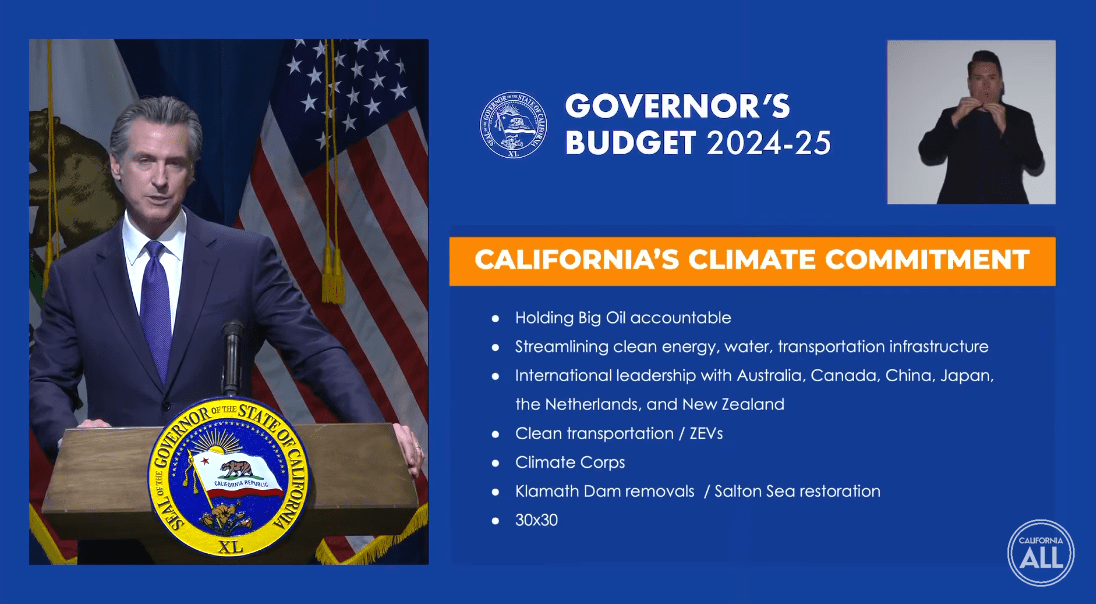"Let's talk about the promises we are keeping," said Governor Newsom at the announcement of his proposed 2024-25 budget yesterday. "California's climate commitment us up there."
Then he outlined his budget proposal, which includes multiple cuts to the state programs that are fighting climate change. He also proposed moving some funding around - using cap-and-trade money for transit, for example, and delaying some funding into future years. And the only cut he proposed for the transportation budget is $200 million from the Active Transportation Program.
Rather than cut, say, highway expansion funds (of which there is plenty - see below), Newsom is quick to propose cuts to the small-but-mighty program that has the potential to do more than almost any other state program to reduce emissions from the transportation sector. Transportation is still the state's biggest source of greenhouse gas emissions, by the way. And that won't change any time soon given the huge amounts of funding that are committed to projects that widen roads and expand access for drivers.
Newsom has to find a way to produce a balanced budget, and given a deficit of $37.9 billion - or $68 billion, depending who you're talking to - it's not an easy task. But his repeated insistence that fighting climate change is a top priority sounds hollow when he doesn't address highway funding.
Note that the Governor must propose a state budget every January, which is discussed and argued over until a final approved budget is passed by the legislature in June. But his proposal focuses solely on the general fund - it doesn't touch other parts of the budget, like that part of the state's transportation budget that comes from state and federal taxes.
That only the Active Transportation Program would be cut reveals something deeper than that proclaimed "climate comittment." For one, it shows an abiding disdain on the part of the Governor and his team for the notion that improvements to biking and walking could benefit more than a tiny minority of people. And that flies in the face of everything we're learning about the safety, health, environmental, and economic benefits of shifting to sustainable transportation modes and even just slowing down car traffic - for everyone, not just those who adopt those modes.
California State Transportation Agency (CalSTA) Secretary Toks Omishakin insisted yesterday that investments in walking, biking, and public transit are "absolutely necessary" to get closer to state goals on transportation safety, climate, and reducing driving. Newsom and Omishakin both repeatedly stated that California is not giving up its commitment to fighting climate change, and claimed that the cut to the ATP "will have no impact on previously awarded funding." They and other agency heads also touted the investments made in the last few years in fighting climate and "benefiting communities."
"As the largest contributor of planet-warming emissions, transportation must be part of the solution," said Omishakin. "And we are not backing down."
Omishakin also said, "We are putting people first, and prioritizing our most important transportation priorities." That's hard to align with being able to maintain 99 percent of transportation funding with the one exception being the ATP.
Neither he nor Newsom proposed a simpler solution: use highway funding to fill that gap. It can be done, but instead they - sadly and regretfully - propose cutting the smallest piece of the transportation budget just a wee bit.
A coalition of advocacy groups offered Newsom some suggestions for balancing the budget in way that instead truly considers the climate crisis: Prioritize spending on sustainable and clean transportation, including transit; suspend investments in new highway capacity; invest highway money in ways that reduce, rather than encourage, driving.
Secretary Omishakin fielded several questions yesterday pertaining to these issues. Despite his insistence that the cut would have "no impact" on the ATP - because any funds already committed to would still go out - future funding is in jeopardy, and as has been endlessly repeated, there is already too little money being invested in improving safety and mobility for people who aren't in cars. This proposed cut would undermine future efforts to build better-designed streets for people by communicating that the ATP is a small, unnecessary, and dispensable program.
But the truth is that, despite the belt-tightening needed with the shrinking General Fund, the transportation budget itself is not shrinking. There is plenty of money for road projects, both from state and federal sources. But if that money just goes for highway expansion, all that will happen is California will dig itself into a deeper hole, in terms of the environment, in terms of car-dependency, and in financial terms, since the state will just be on the hook for future maintenance on any new capacity.
The California Bicycle Coalition breaks down exactly what the state transportation budget looks like, here. As they state, we need to spend more, not less, on Active Transportation, and there's no good reason not to.






